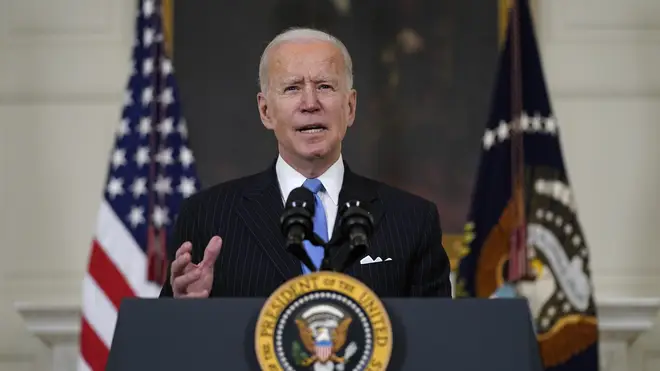
Clare Foges 6pm - 9pm
3 March 2021, 07:44

The target is two months earlier than anticipated.
US president Joe Biden said he expects to take delivery of enough coronavirus vaccines for all adults by the end of May – two months earlier than anticipated – and he pushed states to get at least one dose into the arms of teachers by the end of March.
Mr Biden also announced that drugmaker Merck will help produce rival Johnson & Johnson’s (J&J) newly approved one-shot vaccine, likening the partnership between the two drug companies to the spirit of national cooperation during the Second World War.
He said: “We’re now on track to have enough vaccine supply for every adult in America by the end of May.”
Despite the stepped-up pace of vaccine production, the work of inoculating Americans could extend well into the summer, officials said, depending both on the government’s capacity to deliver doses and Americans’ willingness to roll up their sleeves.
Mr Biden’s announcements quickly raised expectations for when the nation could safely emerge from the pandemic with the promise of speedier vaccinations. But even as he expressed optimism, Mr Biden quickly tempered the outlook for a return to life as it was before the virus hit.
“I’ve been cautioned not to give an answer to that, because we don’t know for sure,” the US leader said, adding that he hopes for a return to normal sometime before “this time next year”.
As Mr Biden spoke, states across the country moved to relax virus-related restrictions.

This came despite the objections of the White House and the nation’s top infectious disease expert, Dr. Anthony Fauci, who have warned against any relaxation of virus protocols until more Americans are vaccinated.
In Texas, Republican governor Greg Abbott moved to lift his state’s mask-wearing mandate and a host of other limitations.
Michigan’s Democratic governor Gretchen Whitmer eased capacity limits on restaurants and both public and residential gatherings.
Dr Fauci has previously said the nation must achieve a vaccination rate of about 80% to reach “herd immunity”.
Only about 8% of the population has been fully vaccinated, according to the Centres for Disease Control and Prevention, though the pace of vaccination has been increasing. The US set a new daily record for injections last Thursday and Friday.
In hopes of increasing vaccinations even further, the Biden administration told governors to make preparations to administer even more doses in the coming weeks.
More jabs are also heading toward the federally-backed programme to administer doses in retail pharmacies, which federal officials believe can double or triple their pace of vaccination.
More than 800,000 doses of the J&J vaccine will also be distributed this week to pharmacies, on top of the 2.4 million they are now getting from Pfizer and Moderna.
Those pharmacies will be key in getting the vaccines into the arms of teachers – particularly in the roughly 20 states where they have not been prioritised for jabs.

The aim is to help reopen schools to better educate students who have been at risk of falling behind during the pandemic and reduce the burden on parents who have had to choose between childcare and a job.
“Let’s treat in-person learning as the essential service that it is,” Mr Biden said.
Teachers will be able to sign up directly through participating retail pharmacies, the administration said.
White House press secretary Jen Psaki also announced that the US federal government is increasing supply of the Moderna and Pfizer vaccines to states next week to 15.2 million doses per week, up from 14.5 million previously. States will also receive 2.8 million doses of the J&J shot this week.
On a call with governors on Tuesday, White House coronavirus coordinator Jeff Zients said states should prepare to administer 16 million to 17 million total weekly doses of Pfizer and Moderna vaccines by the end of March, climbing to 17 million to 18 million weekly by early April.
The supply of J&J doses to states, expected to dip after the initial shipment this week, will climb to four million to six million weekly doses by the end of March, and five million to six million doses weekly through to the end of April.